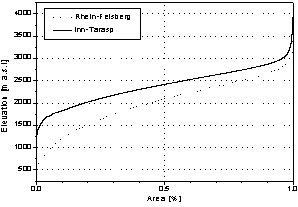Definition of Inputs for the SRM modelModel Settings - Basin Definition - Parameters - Daily Input 0. OverviewThis page explains in more detail, the inputs required by the HYDALP Java implementation of the SRM model. 1. Model SettingsA number of parameters are used by the model to determine the operation of its algorithms in certain respects. 1.1 Update Stream Flow1.2 Peak Rainfall Handling1.3 Temporary Snow Handling1.4 Standard Values2. Basin DefinitionThe model requires information defining the characteristics of the basin being modelled, optionally divided up into a number of separate zones having distinct characteristics with respect to runoff modelling (typically divided into elevation bands).
2.1 Area2.2 Mean Elevation2.3 Maximum Snow Water Equivalence (SWE)3. ParametersParameters and variables which may be available as zonal or basin wide values are always saved for all zones. In case of a basin wide definition, values for zone 1 represent the whole basin. 3.1 Critical TemperatureThe temperature threshold above which precipitation is considered to fall as rain. Otherwise, snow is assumed. 3.2 Time Lag3.3 Recession CoefficientParameter k in SRM formulae. 3.4 Degree-Day FactorParameter a in SRM formulae. 3.5 Runoff Coefficient3.6 Rainfall Contribution4. Daily Input DataThe Snowmelt Runoff Model (SRM) requires a number of inputs for each day of the period modelled, defining the meteorological conditions for the basin, the amount of snow, and observations of runoff at monitoring points. 4.1 TemperatureParameter T in SRM formulae. Air temperature extrapolated to hypsometric mean height of each zone. 4.2 PrecipitationParameter P in SRM formulae. Precipitation falling as rain in each zone. 4.3 Temperature Lapse RateUsed to extrapolate T for each zone. 4.4 Precipitation Lapse Rate4.5 Snow Covered Area (SCA)Parameter A in the SRM formulae. This information is provided for HYDALP from classification of EO satellite data, or extrapolation from such classifications for dates on which insufficient EO data was available. 4.6 Observed Stream Flow |
